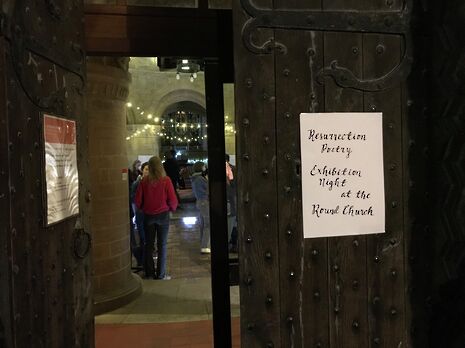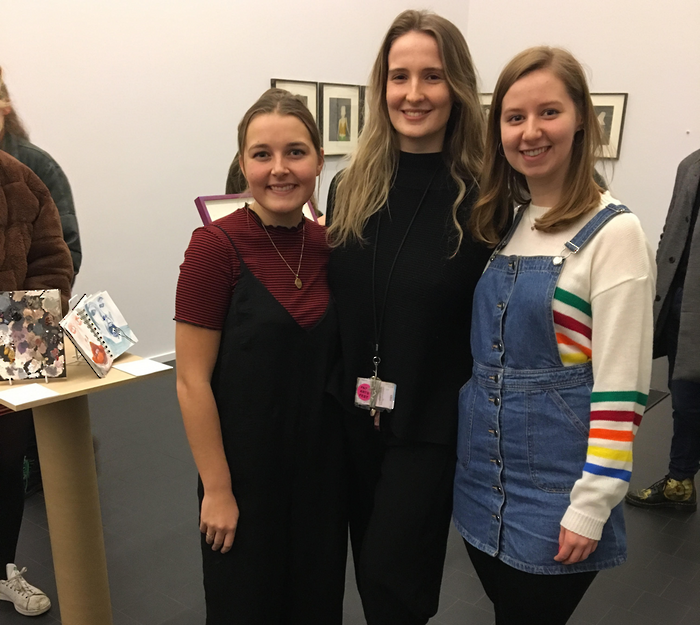Resurrection Poetry exhibition night review: ‘aesthetically pleasing and embracing’
The Christian Union’s recent Resurrection Poetry exhibition and reading was held in the sanctuary of the Round Church

My first step landed on the cold stone of the Round Church, just off Bridge Street. Instantly, I was drawn to the warm glow emanating from the delicate streams of fairy lights, wrapped around the eight towering Norman columns. Chatter greeted me. Faint music played by a band against the backdrop of a stained-glass window and more ambient lighting. I had never been inside the church, nor to a poetry exhibition before and did not know what to expect. That night, it was filled with a small friendly crowd, conversing and drifting between the curved arches, some sitting down, gazing at poems displayed on each pillar.
Resurrection Poetry exhibition night, organised by English students in the Cambridge Inter-Collegiate Christian Union (CICCU), marked the beginning of Easter Term. Although Easter itself has past, the event intended to encapsulate its transcending essence: the grief that comes with falling, but the hope of rising again, which resonates with the often-difficult realities of this forthcoming term. I had initially anticipated a conventional performative event, where the audience sits facing the acts onstage. Instead, we were given the freedom to explore the diverse selection of poetry at our own pace, ranging from Donne and Rosetti, to contemporaries like Evangeline Paterson and Michael Symmons Roberts. Periodically, student artists would recite poetry or perform music, interspersed with Bible readings. The dispersed attention of the room became magnetised by those performances.

One of those student artists (and organiser) was Jonathan Chan. I particularly remember one poem he wrote, titled Pembroke Chapel, eloquently describing his experiences of rehearsing there with the University Gospel Choir. The theme of struggle and trials was not only alluded to by Gospel’s history of black slavery, but also distilled in the striking image of the cross in the chapel, built out of wood from refugee boats. Ana Ovey read Descending Theology: The Resurrection by Mary Karr, graphically depicting the physical suffering Christ’s crucified and battered body endured, into which life eventually re-entered. And that will be Heaven by Paterson caught my eye as I worked my way around the pillars. The imagery of the sunflower constantly and unwaveringly turning towards the sun was beautiful and encapsulated the everlasting hope resurrection represents to Christians. Each displayed poem corresponded with a set of probing questions along with flashcards on which we could reflect, write and share our responses, by attaching them onto the string suspended from the pillars. I was encouraged to contemplate issues like “what does living life to the fullest mean to you?” or “what you love most in the world?”, questions I rarely ask or consider.
As I left the church, I was glad I had attended. The space the organisers created was not just aesthetically pleasing and embracing, but a sanctuary that was open, personal, peaceful and reflective. Held in a typically traditional and sombre place, it celebrated the cornerstone of the Christian faith unconventionally. Event goers had the freedom to explore and discover the meaning of resurrection with their own eyes, ears and voice through discussion. This exhibition was far from the alienating orthodox practice and formalised rituals many think Christianity is. Rather, it was humanised, grounding the distant, ancient elements of the religion into the words of poets, the voices of a new generation, and the vibrant presence in the Round Church that night. Especially throughout this Exam Term, it is important to retain the hope of rising after falling down.
This exhibition was held on the evening of the 28th April
 News / Uni Scout and Guide Club affirms trans inclusion 12 December 2025
News / Uni Scout and Guide Club affirms trans inclusion 12 December 2025 News / Cambridge study finds students learn better with notes than AI13 December 2025
News / Cambridge study finds students learn better with notes than AI13 December 2025 News / Cambridge Vet School gets lifeline year to stay accredited28 November 2025
News / Cambridge Vet School gets lifeline year to stay accredited28 November 2025 Science / Did your ex trip on King’s Parade? The science behind the ‘ick’12 December 2025
Science / Did your ex trip on King’s Parade? The science behind the ‘ick’12 December 2025 News / Pembroke to convert listed office building into accom9 December 2025
News / Pembroke to convert listed office building into accom9 December 2025









